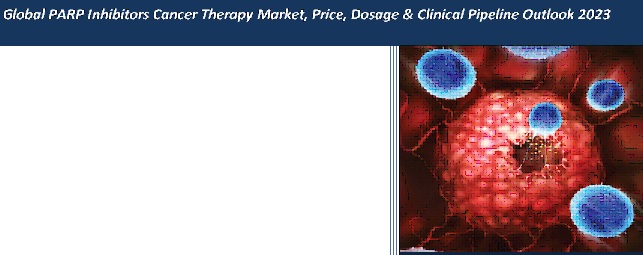Buy USD 20,000 Worth Of Reports (Single User/Multi User License) In USD 8000 Only
“Global PARP Inhibitors Cancer Therapy Market, Price, Dosage and Clinical Pipeline Outlook 2023” report highlights:
-
Current Market Trends and Development Scenario
-
Drug Availability, Dosage and Treatment Schedule
-
Commercially Available Drugs Price Analysis
-
Global Cancer PARP Inhibitors Clinical Pipeline Overview: 31 Drugs
-
Clinical and Patent Insight on Commercially Available Drugs: 3 Drugs
-
Market Segmentation by Drug Patent and Deals
Conventional therapies like surgery, radiotherapy and chemotherapies are currently the dominant form of cancer treatment globally. However, majority of these methods have several limitations with multiple adverse effects which has led to the emergence of much more innovative approach, collectively known as targeted therapies. Targeted cancer therapy segment currently flourishes with several types of therapeutics among which PARP inhibitors have gained immense popularity due to their superior efficacy to conventional therapeutics.
Inhibitors include drugs or substances that block the growth and spread of cancer by interfering with specific molecular targets that are involved in the growth, progression, and spread of cancer. PARP inhibitors are recent entrants in the targeted therapy segment which have gained worldwide popularity as the most common type treatment in certain clinical indications like ovarian cancer and breast cancer.
Poly-ADP Ribose Polymerase or PARP are special proteins that play a key role in assisting damaged cells to repair themselves. The initial clinical testing of PARP inhibitors began nearly a decade ago, following the discovery that these agents in vitro had heightened anticancer activity in cancer cells that harbored BRCA mutations compared to BRCA wild-type cancer cells with intact DNA repair.
Research proved that fault in either of BRCA 1 and BRCA 2 genes have an increased risk of certain types of cancer such as breast cancer, ovarian cancer and prostate cancer. Cells are less likely to repair themselves if there is a fault in one or both of these genes. Blocking PARP with a PARP inhibitor showed impressive results in preventing the proliferation of cancer cells by interfering with their DNA repair mechanism and killing them, thus resulting in a therapeutic outcome.
Currently, there are 3 PARP inhibitors that have been approved for use in patients with suspected or confirmed BRCA-mutated advanced ovarian cancer that has been treated with 3 or more prior lines of chemotherapy. Olaparib (Lynpraza) was the first PARP inhibitor to receive approval in 2014 followed by Rucaparib in 2016 and Niraparib in 2017.
Trends show that the cancer therapy market is steadily shifting from conventional therapeutics to modern therapeutics due to their better safety, efficacy and specificity; thus creating an excellent opportunity for promising therapeutics like PARP inhibitors.
PARP inhibitors have proved to be a commercial success in the modern cancer therapeutic segment. For instance, Lynpraza(Olaparib), marketed by AstraZeneca reported global sales of over US$ 400 Million in 2017; making it one of the most profitable cancer therapy drugs of the year. Lynpraza sales have more than doubled since its approval which projects an optimistic growth in the future. Olaparib is followed by Niraparib with sales of over US$ 109 Million during first nine months of commercial launch. Rucaparib – the most recent PARP inhibitor to enter the market is estimated to generate revenue of over US$ 40 Million by the end of 2018.
The US currently dominates the global PARP inhibitors market leading both in marketing and research followed by Europe. Involvement of regions like South Korea, Japan and Middle East has led to better market penetration and overall better market growth.
The demand for PARP inhibitors has grown exponentially with the increasing incidence of cancer. Further, their enhanced efficacy in cancer treatment when combined with conventional therapeutics like chemotherapy and radiation therapy has led to an exponential growth in sales; which is further strengthened by a robust clinical pipeline under development. With several favorable factors paving the path for success, PARP inhibitors could be one of the leading cancer therapeutics of the future
KuicK Research Analysis of the global PARP inhibitors market provides an in-depth analysis of the current market scenario, trends, dynamics and recent advances that might have an impact on the PARP inhibitors market. Key data like pricing of drugs, sales and cost of therapy per patient have been used to draw an accurate analysis of the PARP inhibitors market. Finally, KuicK Research analysis of forecast and projections regarding the future of PARP Inhibitors market indicate an exciting opportunity waiting in this highly profitable segment of cancer therapy.
